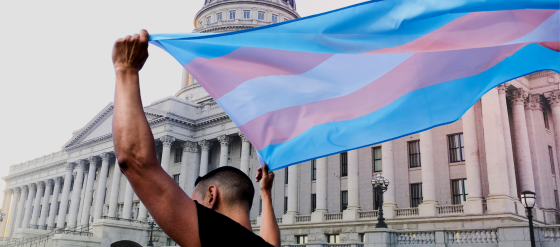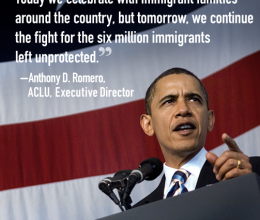
In a 5-4 decision on June 18, the U.S. Supreme Court halted the Trump administration's attempt to end DACA (Deferred Action for Childhood Arrivals), a program enacted during the Obama administration that protects over 700,000 immigrants brought to the U.S. as children from deportation. The majority opinion was written by Chief Justice John Roberts and joined by Justices Ruth Bader Ginsburg, Elena Kagan, Stephen Breyer and (in part) Sonia Sotomayor. This opinion was a powerful victory for Dreamers and activists whose advocacy led to the creation of DACA and the continued fight against this administration’s efforts to dismantle the program.
Download a PDF of this summary (PDF)
Legal Analysis:
>> The Supreme Court's decision was mainly based on a technical point: that the legal reasoning to rescind DACA put forward by the Trump administration in a September 2017 memo did not follow the law that governs administrative agencies.
>> “Home is here!” ACLU of Utah Legal Director John Mejia champions the cause of Utah's Dreamers at a September 2017 rally at the Utah Capitol.
>> The majority of the Court held that the 2017 rescission memorandum, authored by Elaine Duke, the former Deputy Secretary of Homeland Security, represented an "arbitrary and capricious” deviation from prior precedent because it failed to provide adequate reasons as to why the agency was ending the program.
>> The Court noted that the Trump administration, in ending the program, failed to distinguish between two aspects of the DACA program, the “benefits” (granting a work permit) and “forbearance” (the agency's decision to exercise its discretion to not deport someone). Because the Obama administration’s initial June 2012 memo enacting DACA focused heavily on forbearance, and the rescission memo did not mention it at all, this oversight was sufficient, in the eyes of the Court, to make the Duke memo “arbitrary and capricious.”
>> The Court did not decide whether ending DACA itself was legal, but rather focused on how the administration ended the program. This is how Chief Justice Roberts explained the Court’s reasoning in the majority opinion: “We do not decide whether DACA or its rescission are sound policies. The wisdom of those decisions is none of our concern. We address only whether the agency complied with the procedural requirement that it provide a reasoned explanation for its action.”
>> The Court also noted that the Duke memo failed to discuss or consider the “reliance interest” of the community in the DACA program. Reliance interest evaluates how changes to the program would affect hundreds of thousands of people protected by DACA, plus their livelihoods, families, and communities. In April, supporters of DACA sent a briefing to the Supreme Court outlining the high prevalence of DACA recipients and Dreamers among front-line healthcare workers battling COVID-19 pandemic. This example and many others reinforced the degree that the nation relies on individuals with DACA for public services, education, and healthcare. Throughout this section of the opinion you can feel the impact of the inspirational "Home is Here" campaign and advocacy by Dreamers.
>> The Court's decision carefully avoided discussing the power of the executive (i.e. the President) and limited the grounds of its decision to the requirements of the Administrative Procedures Act (APA), which governs the actions by administrative agencies.
>> The majority decision is more complex because Justice Sonia Sotomayor joined all but one section of the majority opinion. In the last section of the opinion, Chief Justice Roberts indicated that claims that DACA was ended out of racial animus should be dismissed. Dissenting, Justice Sotomayor wrote that she believes the Supreme Court was too quick dismiss these claims and should permit the individuals that brought the case to present evidence that the decision to rescind DACA was driven by racial animus from President Trump. In bringing forth these claims, supporters of DACA argued that the President’s statements about immigrants during his 2016 campaign as well as other statements made after he assumed office demonstrated that this decision to end the program was based on racial animus. Justice Sotomayor, reiterating criticisms raised from her dissent in Trump v. Hawaii, the travel ban case, wrote a separate partial concurrence and dissent criticizing the majority opinion for removing challenges to the DACA rescission under the equal protection clause of the 14th Noting the numerous anti-immigrant statements by the President presented by the plaintiffs in the case, Justice Sotomayor criticized the Court’s dismissal of these claims, writing “Taken together, the words of the President help to create the strong perception that the rescission decision was contaminated by impermissible discriminatory animus.” In her opinion, the Plaintiffs should be allowed to present these claims before the lower courts and let the lower courts decide this issue.
Bottom Line:
If you are a federal agency, you can't decide something is illegal by publishing a flimsy legal argument that ignores all the prior justifications. And later, when you realize your legal ground is shaky, try to justify your position with new arguments while the Court is already reviewing the case. Today’s DACA decision by the Supreme Court is another blow to the Trump administration's reckless way of adopting immigration policy. It is also a good reminder of why smart and competent appointments to executive agencies matter, and the Trump administration’s system-wide failure to accomplish that goal. It’s a reminder that no agency is above the law.
Most of all, today’s decision is a reminder of the power and resilience of the Dreamers and activists that have advocated for and defended their right to remain in this country.
What Comes Next?
The fight continues. The DACA cases have been remanded to the lower courts, but Supreme Court decision also creates a pause while real solutions need to happen in Congress. The Department of Homeland Security has yet to articulate how it will implement this decision. It is a reminder that this decision is only a first step towards a real solution. Regardless of the federal government’s response, the ACLU of Utah remains in solidarity with Dreamers, Activists, and allies who have tirelessly fought for and defended Dreamers’ right to remain in the United States.
Update June 25, 2020:
It has been a week since the Supreme Court issued its opinion. In understanding this decision, it is important to remember the role that the Supreme Court, and the judiciary, play in the government’s system of checks and balances. The separation of powers rooted in our constitution was designed to ensure that no branch of government became more powerful than the other two. The framers of the constitution tasked the Supreme Court and the Judiciary branch with interpreting the law and determining the constitutionality of governmental actions. The Court’s decision in DACA embodied the application of checks and balances. Yet, one week later, U.S. Citizenship and Immigration Services (USCIS) the agency within the Department of Homeland Security that administers the DACA program has yet to issue any guidance on how it will implement the Court’s decision. On June 19, 2020, the agency issued a sharp rebuke of the Court’s decision, denouncing the Court’s opinion as “having no basis in law”. To date, it has yet to announce how it will comply with the Court’s directive. Regardless of what it does, Dreamers, Activists, and allies are not giving up. It’s time for Congress to adopt a clean and permanent solution.
If you are interested in finding out more about DACA, this decision, and next steps, we recommend you listen to and follow United We Dream and the National Immigration Law Center.
Did you know that DACA recipients who meet the criteria for bar admission can be admitted to the Utah State Bar? The ACLU of Utah advocated for this change by the Utah Supreme Court that took effect in January 2020. Learn more here: https://www.sltrib.com/news/2020/01/30/undocumented-dreamers-can/

